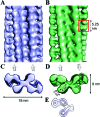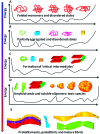Polymorphism in Alzheimer Abeta amyloid organization reflects conformational selection in a rugged energy landscape
- PMID: 20402519
- PMCID: PMC2920034
- DOI: 10.1021/cr900377t
Polymorphism in Alzheimer Abeta amyloid organization reflects conformational selection in a rugged energy landscape
Figures










Similar articles
-
Linking folding with aggregation in Alzheimer's beta-amyloid peptides.Proc Natl Acad Sci U S A. 2007 Oct 23;104(43):16880-5. doi: 10.1073/pnas.0703832104. Epub 2007 Oct 17. Proc Natl Acad Sci U S A. 2007. PMID: 17942695 Free PMC article.
-
Enlightening amyloid fibrils linked to type 2 diabetes and cross-interactions with Aβ.Nat Struct Mol Biol. 2020 Nov;27(11):1006-1008. doi: 10.1038/s41594-020-00523-z. Nat Struct Mol Biol. 2020. PMID: 33097922 No abstract available.
-
Structural polymorphism of Alzheimer Abeta and other amyloid fibrils.Prion. 2009 Apr-Jun;3(2):89-93. doi: 10.4161/pri.3.2.8859. Prion. 2009. PMID: 19597329 Free PMC article. Review.
-
Curcumin Inhibits the Primary Nucleation of Amyloid-Beta Peptide: A Molecular Dynamics Study.Biomolecules. 2020 Sep 15;10(9):1323. doi: 10.3390/biom10091323. Biomolecules. 2020. PMID: 32942739 Free PMC article.
-
Exploring the complexity of amyloid-beta fibrils: structural polymorphisms and molecular interactions.Biochem Soc Trans. 2024 Aug 28;52(4):1631-1646. doi: 10.1042/BST20230854. Biochem Soc Trans. 2024. PMID: 39034652 Review.
Cited by
-
Structural and Functional Insights into α-Synuclein Fibril Polymorphism.Biomolecules. 2021 Sep 28;11(10):1419. doi: 10.3390/biom11101419. Biomolecules. 2021. PMID: 34680054 Free PMC article. Review.
-
Polymorphic C-terminal beta-sheet interactions determine the formation of fibril or amyloid beta-derived diffusible ligand-like globulomer for the Alzheimer Abeta42 dodecamer.J Biol Chem. 2010 Nov 19;285(47):37102-10. doi: 10.1074/jbc.M110.133488. Epub 2010 Sep 16. J Biol Chem. 2010. PMID: 20847046 Free PMC article.
-
Elucidating a relationship between conformational sampling and drug resistance in HIV-1 protease.Biochemistry. 2013 May 14;52(19):3278-88. doi: 10.1021/bi400109d. Epub 2013 May 1. Biochemistry. 2013. PMID: 23566104 Free PMC article.
-
Influence of Hyperglycemic Conditions on Self-Association of the Alzheimer's Amyloid β (Aβ1-42) Peptide.ACS Omega. 2017 May 31;2(5):2134-2147. doi: 10.1021/acsomega.7b00018. Epub 2017 May 17. ACS Omega. 2017. PMID: 30023655 Free PMC article.
-
Structural polymorphism in amyloids: new insights from studies with Y145Stop prion protein fibrils.J Biol Chem. 2011 Dec 9;286(49):42777-42784. doi: 10.1074/jbc.M111.302539. Epub 2011 Oct 15. J Biol Chem. 2011. PMID: 22002245 Free PMC article.
References
-
- Fowler D. M.; Koulov A. V.; Balch W. E.; Kelly J. W. Trends Biochem. Sci. 2007, 32, 217. - PubMed
-
- Maury C. P. J. Intern. Med. 2009, 265, 329. - PubMed
-
- Ahmad A.; Millett I. S.; Doniach S.; Uversky V. N.; Fink A. L. J. Biol. Chem. 2004, 279, 14999. - PubMed
-
- Sipe J. D. Annu. Rev. Biochem. 1992, 61, 947. - PubMed
Publication types
MeSH terms
Substances
Grants and funding
LinkOut - more resources
Full Text Sources
Other Literature Sources
Medical

